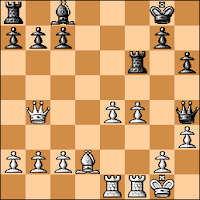1.e4 e5 2.Nf3 Nc6 3.Bc4 Bc5 4.Bxf7+ ...and related lines
(risky/nonrisky lines, tactics & psychology for fast, exciting play)
Tuesday, March 30, 2010
Send in the Clones...
One of the values of playing (and then analyzing) an opening repeatedly – especially a dubious one like the Jerome Gambit (1.e4 e5 2.Nf3 Nc6 3.Bc4 Bc5 4.Bxf7+) – is that the time needed to "think" over-the-board about the first dozen or so moves generally decreases, which can have a psychological impact on an opponent and be doubly useful in a blitz game.
perrypawnpusher - pwr
blitz FICS, 2010
1.e4 e5 2.Nf3 Nc6 3.Bc4 h6
The Semi-Italian Opening.
4.0-0 Nf6 5.Nc3 Bc5
The Semi-Italian Four Knights Game.
6.Bxf7+
The Jerome Gambit way, just like yesterday.
6...Kxf7 7.Nxe5+ Nxe5 8.d4
Before this game I'd only seen this position in my games 5 times – and lost 3 of the games. Well, maybe having a bit more time this time around will be helpful.
8...Bxd4 9.Qxd4 d6
10.f4 Nc6 11.Qd3
So far, just like yesterday's game.
11...Rf8
Instead, perrypawnpusher - HRoark, blitz FICS, 2010 continued 11...Be6 12.Bd2 Nb4 13.Qg3 Nxc2 14.Rac1 Nd4 15.f5 Bd7 16.Qg6+ Kg8 17.Be3 Be8 18.Qg3 Nc6 19.Bf4 Nh5 20.Qe3 Nxf4 21.Rxf4 Qg5 22.Qf2 Ne5 23.h4 Qh5 24.Rd1 a5 25.f6 Ng4 26.Qg3 Qc5+ 27.Kh1 h5 28.Rxg4 hxg4 29.Qxg4 Rh7 30.Rd5 Qf2 31.h5 Qf1+ 32.Kh2 Qxf6 33.Rf5 Qd4 34.Qf3 Bd7 35.Rd5 Qf6 36.Qxf6 gxf6 37.Kg3 Rg7+ 38.Kf3 Bg4+ 39.Kf4 Be6 40.Rd2 Rg5 White resigned
12.Bd2 Kg8 13.Rae1
Black has castled-by-hand. White has developed his pieces.
White does not have enough compensation (a pawn, better center control, better development) for his sacrifice (a piece).
Eventually I am going to have to stop playing this position.
13...Nb4
This move caught me by surprise: What's this? I thought my Queen was safe at d3...
Then I remembered that odd game ontocaustic - defjavid, FICS, 2009 that I had looked while studying my game against HRoark: 11.Qd1 Bg4 12.Qd3 Nb4 13.Qc4+ Kf8 14.Qxb4 Qe7 15.e5 Nh5 16.f5 Qe6 17.fxe6+ Black resigned
Of course my opponent would have kept his advantage with 13...Be6, similar to the HRoark game.
14.Qc4+ d5 15.Qxb4
15...Ng4
Very energetic! Almost enough to make me wonder if my opponent had sacrificed (returned) his Knight to draw my Queen further out of position – so that he could attack on the Kingside...
The more routine 15...dxe4 16.Nxe4 Nxe4 17.Rxe4 Bf5 would have left White better.
16.Nxd5 Qh4
Here we go...
17.h3 Nf6
Well, that didn't last long. I hastened to undo the attacker.
18.Nxf6+
After the game Rybka gave me a chuckle by recommending 18.Ne7+ instead. It's a move worth appreciating.
analysis diagram
Black's King can now go one of three places, and 18...Kh8 is out of the question as it's followed by the fork 19.Ng6+, winning the Queen. The problem is that both 18...Kf7 and 18...Kh7 are answered by 12.Ng6, anyway – and after 12...Kxg6 White captures the Rook on f8, winning the exchange.
18...Rxf6
19.e5
I intended to follow up with f4-f5. It turns out that the pawns would have worked better if I had moved them in the opposite order.
19...Rg6
20.Qb3+
It was only after I chose this move that I realized that 20.f5 was playable (and better) because White's Queen was protected by the Bishop on d2.
20...Be6 21.Qf3 Bxh3
Attack, attack, attack!
A scarier try would have been 21...Rg3, as after 22.Qe2 Black has the creepy 22...Qxh3. Stil, White would have held it together with 23.Rf3.
22.Rf2 Rg3
23.Qxb7
What, me worry??
23...Rf8 24.e6 Rf6
The Black Queen needed to come back to f6, but my opponent wanted to add yet another piece to his attack.
25.e7 Bd7 26.e8Q+ Bxe8 27.Rxe8+
Triumph of the Jerome pawn.
27...Kh7 28.Qe4+ Rgg6
29.Qd3
Even stronger was 29.Qa8.
29...Qg4 30.Ree2 h5
pwr is still attacking!
31.f5 Rd6 32.fxg6+ Rxg6 33.Qf5
33...Qd4 34.Qxh5+ Rh6 35.Bxh6 gxh6 36.Re7+ Kg8 37.Qg6+ Kh8 38.Re8 checkmate
Subscribe to:
Post Comments (Atom)






















No comments:
Post a Comment